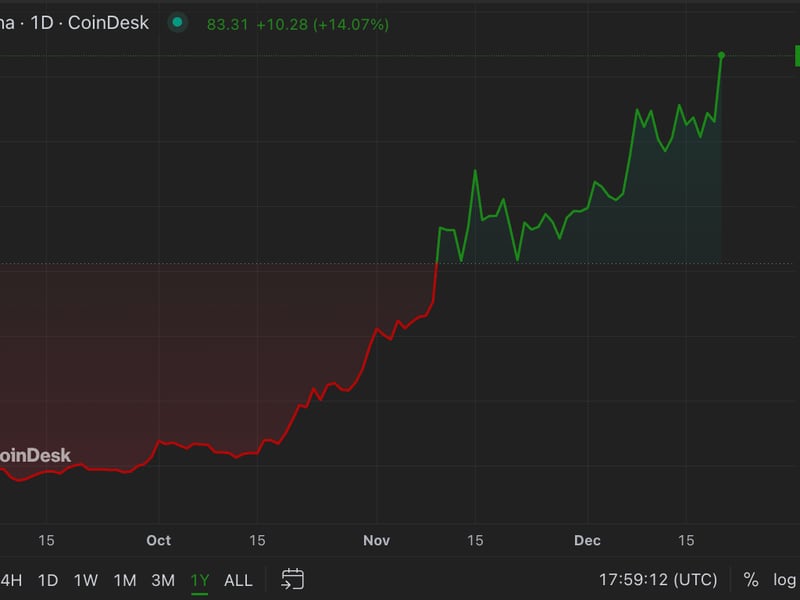Solana, Avax, Helium Led Digital Assets Gains This Year. What's Next?

Layer-1 blockchain Solana [SOL] led the way in 2023 in terms of token price gains, with other altcoins Avalanche [AVAX], Stacks [STX] and Helium’s [HNT] following closely behind. The digital asset gains came as the largest cryptocurrency by market value, bitcoin [BTC], also witnessed a strong year amid growing optimism that spot bitcoin exchange-traded funds (ETFs) will be approved early in the new year.
Solana, which began its sharp increase in mid-October, has gained over 700% since the start of the year. The rally was unaffected by the U.S. Securities and Exchange Commission naming the token among other cryptos as “unregistered securities,” in a complaint against cryptocurrency exchange Coinbase in June.
Solana also fared well despite its relationship with collapsed exchange FTX and its founder Sam Bankman-Fried, whose trial ended in November. Bankman-Fried was a prominent backer of Solana and acquired over $1 billion worth of the tokens through his companies Alameda Research and FTX.
Most of SOL’s gains came following the conclusion of the trial. The network has since seen increased growth in monthly active addresses and the launch of several memecoins including BONK, which was listed recently on crypto exchange Coinbase.
“There were real questions around Solana’s survival after the collapse of FTX, but it has instead thrived with increasing activity on the chain, a newfound appreciation for its innovative technology, and several high profile airdrops,” said Brian Rudick, a senior strategist at GSR.

HNT
Helium’s HNT also made considerable gains in 2023, most of them in December, following the company’s move into the mobile space. Helium migrated to Solana in April from its own blockchain. Helium is a blockchain-based network for Internet of Things devices that uses nodes as hotspots to connect wireless devices to the network.
According to Christopher Martin, director of research at Amberdata, 2023 was a huge year for Helium because of its jump into the mobile sector. “The network seems to have major plans in mobile and IoT, and allowing mobile plan users to earn tokens (MOBILE) by supporting the network and pay the monthly bill with them, creates a flywheel effect for the network,” said Martin.
He also noted that “the recent BONK craze has led the Solana Saga phone to sell out (since the phones come with a BONK claim), which also has a free 30-day subscription to Helium Mobile,” said Martin. “In short, there's a lot of anticipation for MOBILE and HNT to grow with the mobile network due to the symbiotic relationship between the network benefits of user growth.”
AVAX
For Avalanche, there have been a number of institutional partnerships that helped lift the token. AVAX has gained 300% year-to-date. Avalanche announced a partnership with Amazon Web Services in January and was part of J.P. Morgan and Apollo Global's blockchain platform, Onyx’s proof-of-concept project in November.
Chris Newhouse, a former derivatives trader and the founder of Infiniti Labs, a DeFi advisory and consulting firm, said Avalanche’s rally this year has mostly been down to trading on news. “Although this time, I’d argue this isn’t ALL due to the alt L1 narrative that was previously traded in the last cycle (SoLunAvax) where people were just rotating in and out of different L1s and altcoins,”
“Avalanche has made massive strides with institutional partnerships, associating themselves with Apollo and JP Morgan, as well as a previous AWS partnership made at the beginning of the year, and is shaping itself to be one of the best chains conducive to institutional activity,” said Newhouse in an interview with CoinDesk.
Bitcoin also had a strong year in terms of price action, mainly due to enthusiasm surrounding a potential spot bitcoin ETF. The cryptocurrency has gained 164% year-to-date. Rudick said in an interview that the ETF hype was the main catalyst, but a supportive macroeconomic environment helped as well.
STX
Stacks (STX), the native token of Stacks Network, gained 623% over the year. The token rallied in March amid booming hype for Bitcoin Ordinals, a way to inscribe data to the Bitcoin blockchain, and growing total value locked (TVL) on the protocol.
Stacks is known for being the first token distributed through the first-ever U.S. Securities and Exchange Commission (SEC) qualified token offering in 2019. Stacks is a Bitcoin layer-2 protocol for smart contracts that’s attempting to transform and extend Bitcoin’s functionality from its widely known role as an alternative payment system to a more versatile, programmable platform.
Stacks Network’s TVL has surged over the year too, climbing to $50 million from $6 million in January, according to data from DeFiLlama.
More recently, Stacks jumped by 27% on Wednesday following a series of positive comments from veteran investor Tim Draper.
2024 Predictions
Rudick said he expects to see bitcoin and ether [ETH] continue to rally in the new year, helped in part by inflows of likely approvals of spot bitcoin ETFs in the U.S. He also noted that in 2024, “we see decentralized identity ushering in a new wave of blockchain users given plans or announced interest from China, the EU, Brazil, and others.”
Martin said that aside from the ETF focus early in the new year, real-world assets will be the booming segment to watch. “We’ve seen the foundations being set up this year but we haven't seen the mainstream catch up just yet.”
Newhouse said, looking forward, the “Decentralized Physical Infrastructure (DePIN) narrative” will continue to be a hot topic, with tokens such as RNDR and HNT recently outperforming the market. DePINs use cryptocurrency tokens to incentivize building of real-world infrastructure.
“Traditional fund managers have also expressed interest specific in HNT, with Bill Ackman supporting the token in 2022,” Newhouse added.








